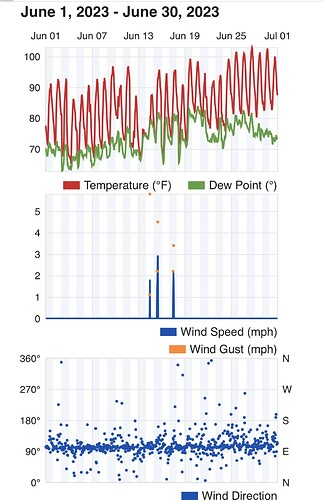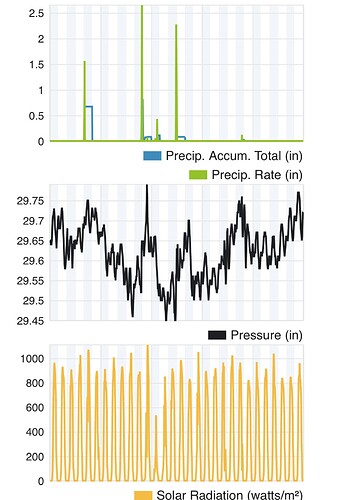I’ve got 8 feet between the rows and 6 feet between each vine. I’ve been aggressively managing canopy all season to keep sunlight/airflow opportunity as high as possible.
I’m not sure how skilled I am at tasting the raw grapes and knowing how that translates to the final wine yet. I try to do it every few days to keep learning and I definitely knew they had a bitter taste when they were around 14 brix and it’s obvious they are getting sweeter and the seeds seem to separating from the pulp in my mouth a little more easily. I’m hopeful I’ll get better at this over time and vintages.
Overall this is great advice, I don’t want to impart an off character in the wine by using any under ripe grapes, but any added acidity would be welcomed so it’s a fine line there. If we’re referencing Zin styles I prefer the lean style with alcohols typically under 14.5 - for these grapes in this vintage I’m likely going to blend everything together (due to yield) and coferment it. Have not quite made that decision yet.
Yeast convert a lot of what’s in the grapes into new compounds, so you’ll recognize some flavors/aromas, but it’s a glimpse, abstract. You can get an idea the volume of flavor, astringency of skins, if there’s harsh green character in the seeds, lingering green in the fruit. We can play a game when processing fruit, trying to guess the brix and acidity from taste, but some of those other aspects can throw off our perception of sweetness or acidity. It’s a good exercise to calibrate yourself and get better at looking beyond the distractions.
I’ll interject that sampling from the vineyard is an advanced skill that many professionals are terrible at. That is, going through the vineyard and attempting to pick a representative sample for an overall picture of how ripe the crop is. I’ve seen people 2.5 brix apart from each other measuring the same block.
I’ve been picking what i think is a representative sample of the vineyard, 5 (ish) grapes all from different vines and then mashing them up in a baggie and using a pipette to pull juice to smear on the refractometer. Hopefully thats the most accurate way to do that. I do sample different grapes throughout and hope that I will learn more about how those flavors impact the final wine as I start making it more often.
This is fascinating to read and to watch…Best of luck…
Have you kept a weather log at all this season?
Better than a weather log that I would try and keep manually…I’m able to tap into a home weather station that a neighbor has just a couple streets over. Check this out:
I have also been keeping track of important milestones like date of bud break, flowering, fruit set, harvest, etc.
Given those temps… have you thought about planting Tempranillo?
80 degree dew point. Sticky.
I know, June was absolutely brutal. Worst heat index we’ve experienced since records were kept. Which explains the massive issues with Black Rot shown above ![]()
I think Tempranillo would ideally have lower temperatures at night. It already has a tendency to high Ph, one of the reasons it’s often blended with other grapes.
-Al
I’m open to any varietals really. The lesson learned from legacy Texas grape growers is don’t try to force varietals because the market dictates it, instead grow what works well for the climate and make good wine, people will adapt.
I don’t know that anything will work better in that heat. The Mourvèdre should work really well and would be my first choice. Others that I would consider would be Grenache, Aglianico, and Tannat.
Aglianico is one I really like and it works for both rose and big reds and I have sparkled it with some success as well. The grape can be a bit fussy, has issues with sulfur, more prone to sunburn, and is more prone to mildew than Mourvèdre or any of the French varieties I grow. Given the issues, one would expect more problems with the fruit but it has been a consistent producer for me. It retains more acidity than most of the other reds I grow and produces wines with more aromatic interest.
I’d throw Graciano in the mix. I grew some in east San Diego county and never had the pH get over 3.3 even during record summers. I planted it on a lark. I alsoI had Tannat and Cab that did well, but the Graciano held the acidity best in what I had planted.
Southern European varieties that thrive at hotter locations is the way to go. I think you have a good selection. Tempranillo is pretty common in Texas. To me, it’s a mucky 2nd rate grape that does pretty good at great sites. Only if you taste a Texas one that excites you should you think about it. Graciano is much better, imo, and a good suggestion. Humidity is a huge factor, so good advice and research for which varieties can handle it is important. No help there from me. For hot climate, Teroldego is widely planted in California’s central valley Sagrantino and the already mentioned Aglianico are ones to think about. From Portugal, maybe Touriga Nacional, Tinta Cao, Alvarelhao.
But, seeing how what you have does is the way to start. If you find you need acid, tannin, aromatics or something else, you could add something for that need.
I took 3 readings for Brix yesterday: the lowest was at 19 and the highest was at 21. Those readings were a little lower than I was expecting given that we have been experiencing heat of 104 degrees and it’s forecasted to get worse. I can tell the vines are stressed because of this and I think the best move right now is to go ahead and pick in the next few days and make a rose (thoughts?)
Having never made a wine before this is the point I’ve been anxious about since the beginning and I’m scrambling to make sure I have the proper supplies.
What I have:
- A bin for crushing
- A stainless tank with a cooling jacket
- A basket press
What I think I need in addition:
- A racking cane
- A carboy with airlock (or 2?)
- A hydrometer
- Potassium Metabisulfite
- Yeast (Lalvin EC 1118?)
- Yeast Nutrients
Where am I wrong? What am I missing?
Your grapes look beautiful, @P_D_e_r_d_e_y_n.
This is very interesting to read about. Thank you for sharing. And, yes, you sure picked a heck of a summer to begin making wine. ![]()
Are the brix reading for all grapes as a blend or by variety? I would expect some difference by variety that might make your range greater than the 19-21 cited. In which case you may want to pick varieties separately.
As for equipment, add funnel, tubing for the racking wand if not already included, digital scale, and a bucket for sanitizing. You will also need something that can be used to measure small quantities of liquid. I used graduated cylinders.
You will need more carboys. You have 120 feet of trellis. At 8 foot spacing, you per foot yield should much higher than what I get. I believe I have read, one pound per foot. If that is correct, that is 120 pounds and at 15 pounds/ gallon, that is 8 gallons. Meaning you need two five gallon and two three gallon carboys at a minimum. I would want to add a few one gallons as well as yields will vary. You will need stoppers and airlocks for all. You want extras to have space available to rack into when neede. With your issues this year, you can work with just two five gallon ones, unless you do multiple picks. But eventually, you will want more.
You will also need the Potassium Metabisulfite and Yeast on your list. EC1118 is fine but to be honest with few exceptions, I haven’t noticed much difference in yeasts especially for rose.
I haven’t used yeast nutrient or a hydrometer in years. They can only help and are nice to have but I don’t find them useful for me.
You may need tartaric acid and an acid test kit. This isn’t vital but if you are concerned about not having enough acidity and want to make adjustments then it is needed.
I am assuming that you are using the Potassium Metabisulfite both to add SO2 and to sanitize equipment. That works fine but in the future you may want to look at starsan and a sprayer as an easier way to sanitize equipment. It just can’t be used on metal as it is a corrosive.
@Brian_Gilp you continue to be a huge resource here for me and I thank you again for your advice.
I did order a funnel, tubing, several food grade buckets in 1 and 3 gallon sizes, and a Ph meter. I know that not having enough acid will be a problem I face and I will certainly come back here with questions about how/when to measure and adjust with tartaric acid.
I also ordered the StarSan, thanks for the tip on not using it on metal!
For those following along with my progress I wanted to share that the plan is to pick tomorrow morning. I’ll follow up with updates on progress and next steps ![]()
Awesome. I feel like I’m watching someone make wine in real time.

